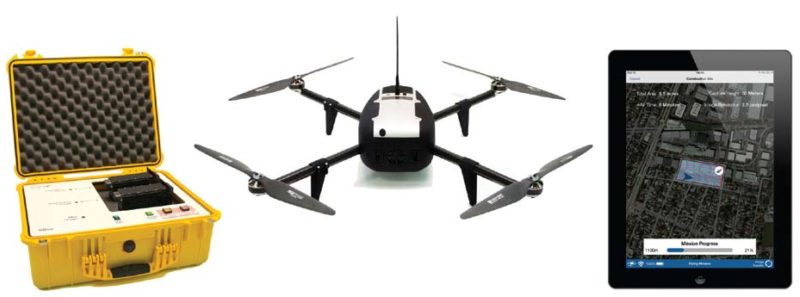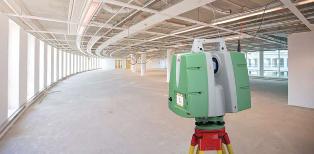High-Tech Devices Emerge in Building Construction
by Jonathan McGaha | 30 November 2015 12:00 am
Developers tout project management and installation precision, safety improvements

Builders and designers have access to more high-tech, data gathering and communication devices than at any previous time. Developers believe these emerging technologies will improve precision and safety as they become more widely adopted. Drones and laser scanners measure work in progress and provide real-time, actionable data. The devices can supply information that otherwise would need to be collected manually possibly exposing workers to hazardous conditions.
New high-tech communication devices promise to improve project management and give team members greater access to instructions and other job-specific information. Augmented reality glasses and wearable technology haven’t become mainstream on job sites yet, but developers believe these products can become integral to the building construction process.
Drone Flights

Drones can be used to survey sites, supply real-time photography of project progress and locate materials, equipment, personnel and other aspects on construction sites. Menlo Park, Calif.-based Kespry Inc. offers a drone system to contractors with annual leases. The Kespry drone system includes the drone, a charger, an iPad with an app to control it and access to cloud-based software to analyze the collected data. Multiple overlapping pictures are stitched together in the software to create 3-D maps of construction sites.
Ryan Donovan, spokesman at Kespry, says his company’s drone is operated without a joystick, a differentiating feature among commercial drones. Users select an area for the drone to fly over with four corners on the app, the drone automatically takes off, follows a flight pattern with geo-fencing and returns to the same spot to land. “It goes back and forth like a lawnmower,” Donovan says.
New York City-based Turner Construction Co., a general contractor, has utilized drones and other high-tech devices on its building construction sites. Chris McFadden, vice president of communications at Turner Construction, says drone images taken during a project for the Sacramento Kings in Sacramento, Calif., were useful managing steel erection. “It monitored the steel progression and compared that to the BIM (building information modeling) model,” he says. McFadden says when his company started using BIM on projects about 10 years ago, he didn’t foresee utilizing the technology on all projects. He says today BIM is part of the normal course of delivering projects.
Kespry Inc., Menlo Park, Calif., www.kespry.com[1]
Precise Laser Scans
In addition to efficiently collecting accurate site measurements during the planning stage, laser scanners can be used throughout projects to compare work with the designed models. This can ensure quality and document the position of components behind walls, above ceilings and below floors, which can be useful to ongoing facility management.
 |
| Photo: Courtesy of Leica Geosystems |
Heerbrugg, Switzerland-based Leica Geosystems released the Leica ScanStation P16 in March 2015. Point-clouds created with the Leica ScanStation P16 can be transferred directly into Mill Valley, Calif.-based AutoDesk Inc.’s Revit BIM software. Cathi Hayes, BIM strategy and business development director at Leica Geosystems, says as-built information can be captured with handheld measurement tools, high-accuracy total stations and high-definition laser scanners during construction
“The accurate discrete measurement points and point clouds are compared against the as-designed model to immediately identify deviations and head off expensive downstream coordination issues in the field,” she says.
McFadden says the precise data produced by laser scanning has made it possible to fabricate more components including those installed above the ceiling in factories, which improves safety and quality. He foresees the drive for more accurate, real-time information and prefabrication continuing to increase. “All of these things are evidence of companies in our industry looking for safer, more efficient ways to build buildings,” he says.
Leica Geosystems, Heerbrugg, Switzerland, www.leica-geosystems.us[2]
Augmented Reality Job Sites
Augmented reality devices overlay an additional element on 3-D environments, referred to as 4-D. Images, sounds, vibrations and other elements may be introduced to a user’s experience. Data collection tasks may be automated and developers believe these devices could become useful to project management.
Los Angeles-based Daqri LLC’s Daqri Smart Helmet is an augmented reality hardhat. It features 360-degree navigation cameras, a high-resolution depth sensor and 4-D, high-definition display positioned beneath a protective visor. The device utilizes Intellitrack, a visual inertial navigation technology. It records high-definition video, photographs, creates 3-D maps and has alphanumeric capture, which allows the device to read signage and instrument data. The device recognizes objects, maps environments and reconstructs 3-D models of structures. Users can touch and control the interface through integration with other devices including smart watches.
 The Daqri Smart Helmet may be used for training and work instructions can be displayed step by step in the context of the job being done. It can progressively compare 3-D site models from project plans with the real build rates to assess projects as they continue. Intellitrack can scan and inventory tools to create inventories, retrieve location information. The Daqri Smart Helmet may be used to identify defect-causing behaviors and complete inspections. High-risk processes can be recorded as they are performed; steps in critical tasks may be replayed. Additionally, digital markers can be placed on construction sites to expedite the punch list process.
The Daqri Smart Helmet may be used for training and work instructions can be displayed step by step in the context of the job being done. It can progressively compare 3-D site models from project plans with the real build rates to assess projects as they continue. Intellitrack can scan and inventory tools to create inventories, retrieve location information. The Daqri Smart Helmet may be used to identify defect-causing behaviors and complete inspections. High-risk processes can be recorded as they are performed; steps in critical tasks may be replayed. Additionally, digital markers can be placed on construction sites to expedite the punch list process.
Daqri LLC, Los Angeles, www.daqri.com[3]
Hands-free Communications
Alternatives to audible communication can improve safety conditions on loud building construction sites. Kitchener, Ontario, Canada-based Thalmic Labs Inc.’s Myo gesture control armband reads electrical activity in muscles and forearm motion. The device can be paired with augmented reality devices to navigate 4-D displays and collect data while performing tasks. Myo could become another device used to connect and coordinate project team members on job sites.
 In the future, will there be drones with laser scanners floating around building construction sites? Will installers peer through augmented reality glasses to position metal panels? Will the whole sequence of project steps be monitored precisely in real-time through a variety of devices? It will be interesting to watch these new technologies continue integrating with each other and throughout the entire building process.
In the future, will there be drones with laser scanners floating around building construction sites? Will installers peer through augmented reality glasses to position metal panels? Will the whole sequence of project steps be monitored precisely in real-time through a variety of devices? It will be interesting to watch these new technologies continue integrating with each other and throughout the entire building process.
Myo by Thalmic Labs Inc., Kitchener, Ontario, Canada, www.myo.com[4]
- www.kespry.com: http://www.kespry.com/
- www.leica-geosystems.us: http://www.leica-geosystems.us/en/index.htm
- www.daqri.com: http://daqri.com/
- www.myo.com: https://www.myo.com/
Source URL: https://www.metalconstructionnews.com/articles/high-tech-devices-emerge-in-building-construction/